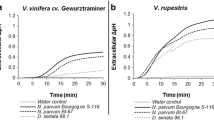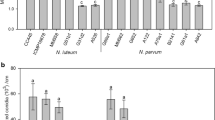Abstract
Botryosphaeria dieback, esca and Eutypa dieback are three economic major grapevine trunk diseases that cause severe yield reduction in vineyards worldwide. The frequency of disease symptoms has increased considerably over the past decade, and no efficient treatment is currently available to control these diseases. The different fungi associated with grapevine trunk diseases mainly induce necrotic wood and characteristic foliar symptoms. In this context, fungi virulence factors and host invasion are not well understood. We hypothesise that extracellular proteins produced by Diplodia seriata and Neofusicoccum parvum, two causal agents associated with Botryosphaeria dieback, are virulence factors responsible for the pathogenicity. In our previous work, we demonstrated that the total extracellular compounds produced by N. parvum induced more necrosis on Chardonnay calli and triggered a different defence gene expression pattern than those produced by D. seriata. Furthermore, this aggressiveness was not clearly correlated with the production of mellein, a characteristic phytotoxin of Botryosphaeriaceae, in our in vitro calli model. To characterise other potential virulence factors and to understand the mechanisms of host invasion by the fungus, we evaluated the profile, quantity and the impact of extracellular proteins produced by these fungi on Vitis vinifera calli necrosis and defence gene expression. Our results reveal that, under the same conditions, N. parvum produces more extracellular proteins and in higher concentrations than D. seriata. With Vitis vinifera cv. Chardonnay cells, we showed that equivalent concentrations of proteins secreted by N. parvum were more aggressive than those of D. seriata in producing necrosis and that they clearly induced more grapevine defence genes.




Similar content being viewed by others
Abbreviations
- RT-qPCR:
-
Reverse transcription-quantitative real time PCR
- Pal :
-
Phaeoacremonium aleophilum
- Pch :
-
Phaemoniella chlamydospora
- Fme :
-
Fomitiporia mediterranea
- GST1 :
-
Glutathion-S-transferase 1
- SOD :
-
Superoxyde dismutase
- AOS :
-
Allene oxyde synthase
- LOX :
-
Lipo-oxygenase
- F3H :
-
Flavonoid-3-hydroxylase
- FMT :
-
Flavonoid-O-methyltransferase
- PAL :
-
Phenylalanine amonia-lyase
- STS1 :
-
Stilbene synthase 1
- PR6 :
-
Pathogenesis related protein 6
- GLU :
-
Glucanase
- CHIT4c :
-
Chitinase 4c
- PR10.1 :
-
Pathogenesis related protein 10.1
- HSR :
-
Hypersensitive response 1
- ACT :
-
Actine
- EF1-Cs :
-
Elongation factor 1-Cabernet sauvignon
References
Abou-Mansour E, Couche E, Tabacchi R (2004) Do fungal naphthalenones have a role in the development of esca symptoms? Phytopathol Mediterr 43:75–82
Andolfi A, Mugnai L, Luque J, Surico G, Cimmino A, Evidente A (2011) Phytotoxins produced by fungi associated with grapevine trunk diseases. Toxins 3:1569–1605
Baillieul F, Genetet I, Kopp M, Saindrenan P, Fritig B, Kauffmann S (1995) A new elicitor of the hypersensitive response in tobacco: a fungal glycoprotein elicits cell death, expression of defence genes, production of salicylic acid, and induction of systemic acquired resistance. Plant J 8(4):551–560
Barthe P, Pujade-Renaud V, Breton F, Gargani D, Thai R, Roumestand C, de Lamotte F (2007) Structural analysis of Cassiicolin, a host-selective protein toxin from Corynespora cassiicola. J Mol Biol 367:89–101
Bertsch C, Kieffer F, Maillot P, Farine S, Butterlin G, Merdinoglu D, Walter B (2005) Genetic chimerism of Vitis vinifera cv. Chardonnay 96 is maintained through organogenesis but not somatic embryogenesis. BMC Plant Biol 5:20
Bertsch C, Ramírez-Suero M, Magnin-Robert M, Larignon P, Chong J, Abou-Mansour E, Spagnolo A, Clément C, Fontaine F (2013) Grapevine trunk diseases: complex and still poorly understood. Plant Pathol 62:243–265
Cobos R, Barreiro C, Mateos RM, Coque JJR (2010) Cytoplasmic- and extracellular-proteome analysis of Diplodia seriata: a phytopathogenic fungus involved in grapevine decline. Proteome Sci 8:46
Cristinzio G (1978) Gravi attacchi di Botryosphaeria obtusa su vite in provincia di Isernia. Informatore Fitopatologico 6:21–23
Crous PW, Gams W (2000) Phaeomoniella chlamydospora gen. et comb. nov., a causal organism of Petri grapevine decline and esca. Phytopathol Mediterr 39:112–118
Crous PW, Gams W, Wingfield MJ, van Wyk PS (1996) Phaeoacremonium gen. nov. associated with wilt and decline diseases of woody hosts and human infections. Mycologia 88:786–796
Crous PW, Slippers B, Wingfield MJ, Rheeder J, Marasas WFO, Phillips AJL, Alves A, Burgess T, Barber P, Groenewald JZ (2006) Phylogenetic lineages in the Botryosphaeriaceae. Stud Mycol 55:235–253
Djoukeng JD, Polli S, Larignon P, Abou-Mansour E (2009) A. Identification of phytotoxins from Botryosphaeria obtusa, a pathogen of black dead arm disease of grapevine. Eur J Plant Pathol 124:303–308
Duncan DB (1955) Multiple range and multiple F tests. Biometrics 11:1–41
Dupont J, Wassila L, Magnin S, Larignon P, RoquebertT M.F (2000) Phaeoacremonium viticola, a new species associated with Esca disease of grapevine in France. Mycologia 92: 499–504
Evidente A, Punzo B, Andolfi A, Cimmino A, Melck D, Luque J (2010) Lipophilic phytotoxins produced by Neofusicoccum parvum, a grapevine canker agent. Phytopathol Mediterr 49:74–79
Fischer M (2002) A new wood-decaying basidiomycete species associated with esca of grapevine: Fomitiporia mediterranea (Hymenochaetales). Mycol Prog 1(3):315–324
Hellemans J, Mortier G, De Paepe A, Speleman F, Vandesompele J (2007) qBase relative quantification framework and software for management and automated analysis of real-time quantitative PCR data. Genome Biol 8(2):R19
Larignon P (2012) Maladies cryptogamiques du bois de la vigne: symptomatologie et agents pathogènes. http://wwwvignevin.com
Larignon P, Dubos B (2001) Le Black Dead Arm. Maladie nouvelle à ne pas confondre avec l’esca. Phytoma 538:26–29
Larignon P, Fulchie R, Cere L, B. Dubos B (2001) Observations on black dead arm in French vineyards. Phytopathol Mediterr 40 Supplement, S336–S342
Lehoczky J (1974) Black Dead-arm disease of grapevine caused by Botryosphaeria stevensii infection. Acta Phytopathol Acad Sci Hung 9:319–327
Luini E, Fleurat-Leussard P, Rousseau L, Roblin G, Berjeaud JM (2010) Inhibitory effects of polypeptides secreted by the grapevine pathogens Phaeomoniella chlamydospora and Phaeoacremonium aleophilum on plant cell activities. Physiol Mol Plant Pathol 74:403–411
Martos S, Andolfi A, Luque J, Mugnai L, Surico G, Evidente A (2008) Production of phytotoxic metabolites by five species of Botryosphaeriaceae causing decline on grapevines, with special interest in the species Neofusicoccum luteum and N. parvum. Eur J Plant Pathol 121:451–461
Mauro M, Nef C, Fallot J (1986) Stimulation of somatic embryogenesis and plant regeneration from anther culture of Vitis vinifera cv. Cabernet-Sauvignon. Plant Cell Rep 5:377–380
Mugnai L, Graniti A, Surico G (1999) Esca (black measles) and brown wood-streaking : two old and elusive diseases of grapevines. Plant Dis 83:404–418
Octave S, Amboradé BE, Luini E, Ferreira T, Fleurat-Leussard P, Roblin G (2005) Antifungal effects of cysteine towards Eutypa lata a pathogen of vineyards. Plant Physiol Biochem 43:1006–1013
Octave S, Roblin G, Vachaud M, Fleurat-Leussard P (2006a) Polypeptide metabolites secreted by the fungal pathogen Eutypa lata participate in Vitis vinifera cell structure damage observed in Eutypa dieback. Funct Plant Biol 33:297–307
Octave S, Amboradé BE, Fleurat-Leussard P, Bergès T, Roblin G (2006b) Modifications of plant cell activities by polypeptides secreted by Eutypa lata, a vineyard fungal pathogen. Physiol Plant 128:103–115
Octave S, Roblin G, Fleurat-Leussard P (2008) Effects of non-glycosylated and glycosylated polypeptides secreted by the grapevine pathogen Eutypa lata, on the structural features and membrane processes in grapevine cells. J Plant Pathol 90(2):211–224
Pennycook SR, Samuels GJ (1985) Botryosphaeria and Fusicoccum species associated with ripe fruit rot of Actinidia deliciosa (kiwifruit) in New Zealand. Mycotaxon 24:445–58
Perrin M, Gertz C, Masson JE (2004) High efficiency of regenerable embryogenic callus from anther filaments of 19-grapevine genotypes grown worldwide. Plant Sci 167:1343–1349
Phillips AJL (2002) Botryosphaeria species associated with diseases of grapevines in Portugal. Phytopathol Mediterr 41:3–18
Ramirez-Suero M, Bénard-Gellon M, Chong J, Laloue H, Stempien E, Abou-Mansour E, Fontaine F, Larignon P, Mazet-Kieffer F, Farine S, Bertsch C (2014) Extracellular compounds produced by fungi associated with Botryosphaeria dieback induce differential defence gene expression patterns and necrosis in Vitis vinifera cv. Chardonnay cells. Protoplasma. doi:10.1007/s00709-014-0643-y
Rappaz F (1984) Les éspèces sanctionnées du genre Eutypa (Diatrypacae, Ascomycetes). Etude taxonomique et nomenclaturale. Mycotaxon 20:567–586
Rovesti L, Montermini A (1987) Un deperimento della vite causato da Sphaeropsis malorum diffuso in provincia di Reggio Emilia. Inf Fitopatol 1:59–61
Scheck HJ, Vasquez SJ, Gubler WD (1998) First report of three Phaeoacremonium spp. causing young grapevine decline in California. Plant Dis 82, 590 (abstract)
Shoemaker RA (1964) Conidial states of some Botryosphaeria species on Vitis and Quercus. Can J Bot 42:1297–1301
Slippers B, Wingfield M (2007) Botryosphaeriaceae as endophytes and latent pathogens of woody plants: diversity, ecology and impact. Fungal Biol Rev 21:90–106
Tabacchi R, Fkyerat A, Poliart C, Dubin DM (2000) Phytotoxins from fungi of esca of grapevine. Phytopathol Mediterr 39:156–161
Valtaud C, Foyer CH, Fleurat-Leussard P, Bourbouloux A (2009) Systemic effects on leaf glutathione metabolism and defense protein expression caused by esca infection in grapevines. Funct Plant Biol 36:260–279
Van Niekerk JM, Crous PW, Groenewald JZ, Fourie PH, Halleen F (2004) DNA phylogeny, morphology and pathogenicity of Botryosphaeria species on grapevines. Mycologia 96:781–798
Van Niekerk JM, Fourie PH, Halleen F, Crous PW (2006) Bostryosphaeria spp. as grapevine runk disease pathogens. Phytopathol Mediterr 45:S43–S54
Wevelsiep L, Kogel KH, Knogge W (1991) Purification and characterization of peptides from Rhynchosporium secalis inducing necrosis in barley. Physiol Mol Plant Pathol 39:471–482
Yan JY, Xie Y, Zhang W, Wang Y, Liu JK, Hyde KD, Seem RC, Zhang GZ, Yao SW, Bai XJ, Dissanayake AJ, Peng YL, Li XH (2013) Species of Botryosphaeriaceae involved in grapevine dieback in China. Fungal Divers 61:221–236
Acknowledgments
This research was financed by CASDAR V1301 (Compte d’Affectation Spéciale au Développement Agricole et Rural), Alsace Region (France) and CIVA (Conseil Interprofessionnels des Vins d’Alsace).
Conflict of interest
All authors read and approved this manuscript and declare no competing interests.
Author information
Authors and Affiliations
Corresponding authors
Additional information
Handling Editor: Hanns H. Kassemeyer
*M. Bénard-Gellon and S. Farine contributed equally to this work.
Rights and permissions
About this article
Cite this article
Bénard-Gellon, M., Farine, S., Goddard, M.L. et al. Toxicity of extracellular proteins from Diplodia seriata and Neofusicoccum parvum involved in grapevine Botryosphaeria dieback. Protoplasma 252, 679–687 (2015). https://doi.org/10.1007/s00709-014-0716-y
Received:
Accepted:
Published:
Issue Date:
DOI: https://doi.org/10.1007/s00709-014-0716-y




